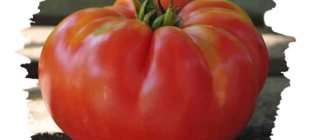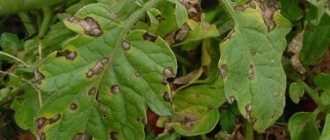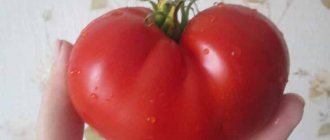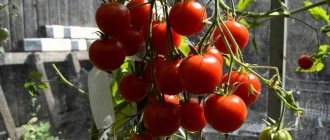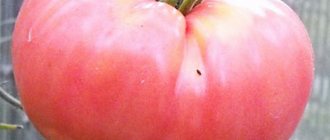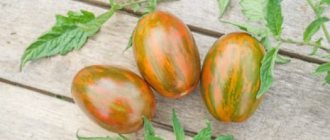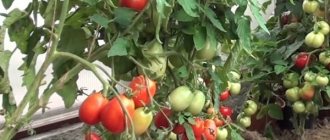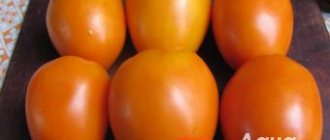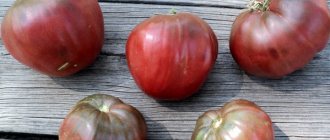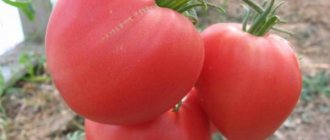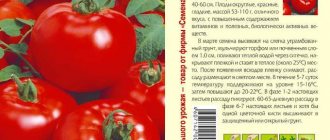The Bullfinch tomato was developed specifically for the northern regions of Russia, where the climate and weather do not meet the requirements for growing tomatoes. The variety adapts to any conditions - it grows without sufficient light, and is not afraid of frost and low temperatures. At the same time, it preserves fruiting and productivity.
Tomato seeds of the “Bullfinches” variety
Grown fruits of this variety
The “Bullfinch” variety is unpretentious and can grow in various conditions.
General characteristics of the variety
Bullfinch is a determinate variety with a strong trunk that does not differ in significant height (maximum 40 cm). The tomato does not need pinching, gartering or pruning, which makes caring for tomatoes easier. However, with high yields, it is advisable to install a support (wooden pegs). If the variety grows in the middle zone, then it can be planted without greenhouse conditions - directly into the ground.
Appearance of bushes
The bushes are characterized by short stature and small leaves. The number of trunks is from one to 2. Foliage is average, height is from 30 to 40 cm, standard variety.
One brush contains 3-5 tomatoes. The first tomatoes are located above the 6th leaf, the others - after 1-2 leaves.
Description of fruits
Tomato fruits are quite sweet and juicy, but not watery. They have a bright, rich red hue. They differ in the following indicators:
- pulp – moderately dense;
- the number of seeds is insignificant;
- shape – round, even, smooth, sometimes slightly flattened;
- weight varies from 140 grams to 160;
- the color of unripe fruits is dark green;
- the peel is thin, but compacted, so the tomatoes do not crack;
- used for canning, making juices and salads.
Ripening time and yield
Bullfinch is a super-early ripening variety that ripens within 90-97 days after germination.
One stem can have up to 6 brushes, each of which produces at least 3 tomatoes. For 1 sq. m accounts for 6-7 kg of harvest.
To increase productivity, you need to pay attention to the acidity of the soil, the quality of the seeds and seedlings planted, the nutritional value and looseness of the soil. It is important to feed and water the bushes in a timely manner.
It is not advisable to replant flowering shrubs or overfeed them. If underdeveloped seedlings are planted in the soil, the ripening period increases by a couple of weeks, since the bushes take longer to take root.
Description of tomatoes Bullfinch
The Bullfinch tomato belongs to the super-early determinate miniature varieties. The bush does not require shaping and reaches 30-50 cm in height. Has medium foliage. The leaves are small, carved, dark green in color, pubescent on the underside.
Attention! The main advantage of the Bullfinch tomato is its ability to bear fruit in the absence of light and heat; the name of the variety speaks for itself.
Description of fruits
The number of fruits in a bunch of tomatoes of the Bullfinch variety is from 3 to 5 pieces. They grow weighing up to 150 g, have a pleasant, sweet, non-watery taste and rich red color, with moderately dense pulp and a small number of seeds. Ripe tomatoes are almost round in shape, slightly flattened, with slight ribbing. Thin but dense skin protects them from cracking, which makes it possible to preserve them as a whole fruit.
Features of planting and growing
If seeds are purchased in a store, it is necessary to check them for germination quality and prepare the seeds for germination. How to do it:
- prepare settled water (you can use melt water);
- heat the liquid to 50 degrees;
- add seeds;
- let stand until cool;
- collect hollow elements that float to the surface of the container;
- add growth stimulants to the water;
- leave for 3 hours;
- remove the seeds and dry.
As a stimulant, you can use factory-made Epin, honey with water (for 200 ml you need 1 teaspoon of beekeeping product) or 18-20 drops of natural aloe juice for the same amount of water.
Planting seedlings
Before planting seeds, special containers and soil are prepared (calcine the soil in the oven, add a little compost, peat, ash and sand). You can use store-bought primer. Next, tomatoes are planted as seedlings and seedlings are grown according to the following rules:
- Prepare the place and pour out the soil. There should be enough lighting, but it cannot be open sunlight.
- Level the soil, then make small furrows (maximum depth - one and a half to two centimeters). For this, ordinary matches are used.
- The seeds are placed at a distance of 2 cm from each other.
- Soil is sprinkled on top.
- To speed up the seed pecking process, you can cover them with polyethylene. If this method is used, the boxes must be opened occasionally to ventilate the soil.
- When the first shoots appear, the film is completely removed and the containers are transferred to the sun.
- After the appearance of 2 leaves, the seedlings are planted in different pots. It is important to select strong bushes and remove weak ones.
- After 7 days, tomato seedlings are fed with nitrogen-mineral fertilizers.
- After 14 days, a urea solution is added (can be replaced with ammonium nitrate).
- A couple of weeks before the next transplant, it is necessary to take the seedlings out onto the veranda or balcony every day so that they can more easily adapt to street or greenhouse conditions. You need to start hardening from the 1st hour, gradually increasing the time.
Until strong bushes are formed, it is strictly forbidden to water with a watering can, as the seeds are washed away. Spray bottles are used for moisturizing.
Transfer
Tomatoes can be transplanted into open ground at different times. It depends on the region of growth, but there is one main rule - planting is carried out when there is no risk of frost.
In the Central regions of the Russian Federation, Bullfinch tomatoes are transplanted into the garden after the 20th of April or at the beginning of May. As for the Northern part, the landing takes place no earlier than the end of May or the beginning of June.
Rules:
- The distance between rows should be 60-70 cm, and between bushes - 40-50 cm.
- The hole should have a size of 30x30x30.
- At the bottom of the hole you need to pour superphosphate, which is resistant to dissolution. This makes it possible to constantly maintain the required level of fertilizer in the soil. A half-liter jar of compost is also placed here, along with a handful of droppings and ash.
- Water is poured from above.
- The bushes are removed from the soil, leaving a lump of earth.
- Place in the hole.
- Watering is prohibited for 6-7 days.
How to water bushes?
The first watering is carried out after a week, then moistening is not carried out too often, since the variety tolerates drought well, and pathogenic microorganisms multiply in an overly humid environment.
The following requirements must be adhered to:
- use warm water (preferably settled);
- It is better to carry out irrigation in the evening, since during the day and morning watering drops of water remain on the leaves, which burn them under the influence of sunlight;
- About a liter of liquid is needed per bush;
- After moistening, the soil is mulched using any natural material (straw, peat, sawdust, grass).
Top dressing
Primary feeding is carried out a couple of weeks after transplantation. For this purpose, nitrogen fertilizers, manure tinctures, and herbs are used.
Secondary feeding is carried out during budding. Fertilizer based on potassium and phosphorus is introduced into the soil. Be sure to add ash or potassium monophosphate.
Loosening and weeding
Loosening is carried out together with watering the plants, thanks to which the roots are fed with oxygen. Weeding should be done regularly. Pruning is not carried out because the plant is undersized.
Features of growing in a greenhouse and in open ground
The only difference in growing Bullfinch in greenhouse and outdoor conditions is that the greenhouse must be constantly ventilated. Also, temperatures should not be too high, as this will sterilize the pollen.
Read this article to help you grow tomatoes in open ground.
Diseases and pests
The bullfinch is not afraid of late blight. This is due to the early ripening of fruits. The variety is not afraid of fungal infections, blossom end rot, brown spot and gray rot. However, if not properly cared for, the plant’s immune system becomes weakened, so it is advisable to take preventive measures. They are as follows:
- remove weeds in a timely manner;
- before planting in open ground, treat the soil with boiling water, copper sulfate, and potassium permanganate;
- periodically treat with Fitosporin;
- Before planting, keep the seeds in a weak solution of manganese;
- do not plant in an area where tomatoes have been growing for 3 years;
- transplant from nightshade crops;
- avoid high humidity (do not flood, but cover the beds with plastic film when it rains);
- If one of the bushes is damaged, destroy it and disinfect the remaining plants.
The variety is susceptible to parasite invasion. This could be aphids, armyworms, Colorado potato beetles, slugs, and whiteflies. To avoid defeat, you must do the following:
- spray with soap solution;
- use celandine tincture;
- add hot pepper and mustard to the soil;
- plant basil spice, marigold flowers or tobacco nearby.
Features of cultivation
Tomato seeds for seedlings are planted in the ground after March 15th. Plastic containers or peat cups are suitable for this. The soil is prepared from garden soil, humus, and sand.
Before planting, the soil is spilled with boiling water or a weak solution of manganese.
The seeds are planted in moistened soil to a depth of no more than 1.5 cm, sprinkled with fluffy soil on top, sprayed with water from a spray bottle, and wrapped in cling film. The room temperature should be maintained at least + 22 ᵒC.
After the first shoots appear, the film is removed. The seedlings are watered as the earthen clod dries out. The room temperature is reduced to + 18 ᵒС.
Important! During the period of growth of Bullfinch tomato seedlings, it is necessary to install special phytolamps to illuminate the plants for at least 12 hours a day.
After 2 true leaves appear on the seedlings, they are planted in larger, separate containers, this contributes to the formation of a strong root system
As soon as the stem gets stronger and there are more than four leaves, the seedlings are fed. A complex fertilizer is suitable for these purposes. It is important that it contains nitrogen.
Transplantation of seedlings into open ground is carried out at the end of May. By this time the earth should warm up, it is important to exclude the possibility of night frosts.
Before transferring seedlings to open ground, it is prepared: the beds are dug up with humus or manure, and the ground is thoroughly loosened. Then holes are cut and dug at a distance of 40 cm in rows and 60 cm between rows.
Important! When planting, adhere to the following rule: place no more than 6 tomato bushes per 1 m2.
The day before planting, the seedlings are watered abundantly; this procedure will make it easier to remove them from the container. The young plant is transplanted into prepared holes, dug in with earth, and compacted.
In the first week after transfer, the seedlings are covered with film so that the adaptation period passes for the plant in the most comfortable conditions.
During the growth period, Snegir tomatoes are fertilized once with complex mineral compounds. During the period of ovary formation, the bushes are topped with mullein infusion. As soon as the fruits begin to ripen, fertilization should be stopped.
The Bullfinch tomato does not need frequent watering. The procedure is carried out as the soil dries out. For these purposes, warm, settled water is used. To prevent burns on the leaves and stems of tomatoes, watering is carried out only in the evening. Do not allow the soil to become waterlogged and water to stagnate near the plant, as this leads to the proliferation of fungi. After watering, the soil is loosened.
Water is poured only at the root, avoiding as much as possible the liquid getting on the green part of the plant, so as not to cause burns
The culture does not need stepsoning. During the period of ovary formation, the bushes are tied up. This is due to the fact that a large number of fruits appear on the stems; as they ripen, they break the shoots.
Garden and greenhouse Snegir tomatoes equally need support
Harvest and storage
Due to the fact that the Bullfinch has a fairly dense peel, it is easy to preserve the harvest. Due to the lack of cracking effect, the crop is harvested in its mature form. If very long-term storage or transportation is required, then it is advisable to collect it in a brown state.
Storage rules:
- the room is equipped with a ventilation system;
- tomatoes are placed in wooden boxes, which are filled with sawdust;
- the fruits should not have mechanical damage or diseases;
- When picking tomatoes, the tails are left on them;
- basement temperature – from 10 to 12 degrees;
- indoor air humidity should not exceed 80%;
- shelf life - 2 months.
Diseases and pests: prevention and control methods
Tomatoes of the Bullfinch variety are resistant to many diseases: brown leaf spot, gray or blossom end rot. To prevent the appearance of fungus or viruses, it is recommended to spill the soil with a hot solution of potassium permanganate. Young plants are sprayed with phytosporin or other biological preparation. Frequent loosening of the soil and timely removal of weeds will help protect the plantings.
Insecticides will help get rid of pests. They can be used before flowering begins; after fruit set, folk remedies are used: infusion of celandine or onion peel, an aqueous solution of laundry soap.
Cold-resistant and unpretentious Bullfinch tomatoes are an excellent choice for a beginning gardener who does not have a greenhouse. The bright red fruits are very tasty, and they ripen earlier than many common varieties.
Pros and cons of Bullfinch tomatoes
Advantages of the Bullfinch variety:
- unpretentiousness of care;
- the ability to plant seedlings directly in open ground;
- resistance to low temperatures;
- early maturation;
- the entire harvest can be harvested at one time;
- possibility of transportation and long-term storage;
- excellent taste and juiciness;
- wide range of applications;
- no need to pruning or tying up bushes;
- excellent yield;
- resistance to diseases.
shortcomings found, but immunity to high humidity can be noted.
Characteristics of tomato
The Bullfinch tomato was bred specifically for the Central Black Earth and Northern zones for cultivation both in open ground and under cover. In northern summer conditions, the variety must have time to grow and produce a full harvest. It is possible to plant small but strong tomato bushes in flowerpots and containers located on verandas, balconies and window sills. A short-term drop in temperature is not critical for the Bullfinch tomato variety, just like a lack of moisture, although good care will provide excellent results.
Productivity and fruiting
The Snegir variety is super early. From the time the seeds germinate until the tomatoes turn red, it takes from 95 to 100 days. If the trunk is formed into 2 stems, then on each you can get up to 6 clusters of 3-5 fruits each. From 1 sq. m yield with good care is up to 6.5 kg of tomatoes. In the North-Western regions, you can get a harvest as early as July in the absence of shelter.
What affects productivity
The yield of tomatoes of the Snegir variety is affected by:
- seed quality;
- quality of seedlings;
- soil nutrition;
- quality and quantity of fertilizing and watering;
- soil acidity;
- predecessors.
The first 2 points are decisive in the quantity and quality of the variety’s harvest. Bad seeds cannot produce good seedlings. And, the conditions in which the seedlings were grown affect the yield as a whole. Underdeveloped plants will spend a lot of effort on taking root in the ground, overfed ones will produce a lot of greenery and a minimum yield of tomatoes, flowering ones can drop all their buds when transplanted. Tomato harvest will be delayed by 1 or 2 weeks.
The soil also has certain requirements. It should be loose and nutritious, with a neutral pH.
Tomatoes need feeding when planted in the ground, but in all cases one rule applies: underfeeding is better than overfeeding. Overfed plants have thick trunks and leaves, buds set late and weakly, and productivity decreases.
When planting tomato seedlings of the Bullfinch variety in the ground, it is necessary to take into account which plants were the predecessors of tomatoes in previous years. The most successful will be cabbage, peas, and beans. You cannot plant after representatives of the same species (potatoes, eggplants), as there is a high probability of exposing tomatoes to various diseases under unfavorable conditions.
Warning! Acidic soils reduce tomato yields. Loamy and sandy loam soils are most suitable for growth.
Areas of use
Ripe Snegir tomatoes are eaten:
- fresh;
- when preparing first and second courses;
- for preparing fresh and canned salads;
- in the preservation of whole fruits;
- for preparing purees, pastes, juices for the winter.
Resistance to diseases and pests
Tomato is not afraid of fungal diseases and late blight. Prevention measures for the Bullfinch variety are:
- spilling the soil before planting with a hot pink solution of KMnO4;
- constant loosening of the soil around the roots;
- weed removal;
- treatment of seedlings after planting in the ground with biological products (“Fitosporin”).
Among insects, the enemies of tomatoes are Colorado potato beetles, cutworms, and aphids.
Advantages and disadvantages of the variety
The main advantages of the Bullfinch tomato variety are:
- excellent taste of tomatoes and the ability to transport them;
- early and friendly maturation;
- Bullfinch tomatoes are suitable for consumption both fresh and canned;
- the bush is small in height and does not require pinching or staking;
- resistance to temperature changes;
- possibility of growing in open ground and under cover;
- resistance to fungal diseases (brown spot and late blight).
Important! Breeders did not notice any shortcomings in this variety.
Reviews
★★★★★
Ksenia, 33 years old. For our region, Snegir is the best option.
Moreover, it ripens quickly and early, when late blight is not yet so widespread. Personally, I harvest at the beginning of August, and this is provided that I plant it in the ground in the garden. The good news is that the seedlings quickly take root; the main thing is to remove weak bushes. One of the minuses I would like to note is that when the summer is very rainy, you have to make a plastic awning over the bushes to protect them from humidity. Otherwise, the taste is wonderful, I use it for food and canning. ★★★★★
Sergey, 46 years old. I have been raising Bullfinch for about six years.
Overall, I’m happy with the variety, but I don’t agree with one thing: the bushes don’t need to be tied up. In reality, you have to do this because the bushes are very heavy and there are a lot of tomatoes on the bunches. But I usually don’t just tie it up, but install it on wooden supports. ★★★★★
Valentina, 53 years old. To be honest, I was surprised by the Bullfinch variety.
I once planted seedlings, collected them in the fall, and then ended up in the hospital, so I had a few tomatoes left at the dacha. The next year, to my surprise (and in this place I had already planted bell peppers), tomato shoots appeared. I quickly replanted them and they produced a good harvest. Hide
Add your review
The Bullfinch tomato is grown in any conditions - in open ground, in a greenhouse, and even in the Northern regions of Russia. It has excellent yield and taste, thanks to which the variety has won a well-deserved leading place. And the unpretentiousness of care allows you to plant seedlings in summer cottages, where the owners come only once a week.
0
0
Copy link
Pest and disease control
Bullfinch tomatoes are resistant to late blight, brown spot, rot and other fungal diseases. To protect the plant, the soil is disinfected before planting the seeds by pouring boiling water or a weak solution of potassium permanganate. The same procedure is carried out in the beds if there is a high probability of infection.
It is important to hill up grown bushes with tomatoes in time and remove weeds. This way you can avoid the proliferation of fungus and harmful insects.
When pests appear, tomatoes are sprayed with chemicals. I use them at the flowering stage. When the first ovaries appear, only traditional methods of controlling pests and diseases are used.
Growing rules
It is recommended to grow bullfinch as seedlings. Before using seeds, be sure to treat them with a stimulant, which will increase the germination rate and accelerate the growth of seedlings. The substrate can be made from ordinary garden soil - reviews from gardeners say that it is necessary to add humus to such soil, or maybe some sand. Seeds must be sown in containers with a depth of 2 cm. For the germination of Snegir tomato seedlings, a temperature of about 25 degrees is needed. Since this variety is quite well known, it is recommended to buy seeds from trusted sellers to avoid buying a fake.
Seeds for planting are sown three months before the intended planting in the garden. It is necessary to pick seedlings at the stage of appearance of two true leaves. When planting in a permanent place, it is recommended to distribute the seedlings freely, for example, it is permissible to plant five bushes on 1 square meter of land. It is preferable to feed the plant with fertilizer with a high nitrogen content - this will strengthen the stems. A week before planting, seedlings are usually hardened off by taking them to a cool place, first for a couple of hours, and then for a day.
Planting seedlings in the ground begins closer to June, when the ground has had time to warm up sufficiently. It is recommended to plant tomatoes in beds where legumes, carrots or cabbage previously grew.
Anyone who has planted this variety already knows that it is undesirable to place tomatoes in beds where zucchini, tomatoes or peppers were previously grown. The soil needs to be fertilized with humus, and the bushes should be placed at a distance of 30 centimeters from each other.
Anyone who has grown Snegir tomatoes knows that in the first days after transplanting, young seedlings should be covered with film. Further care of the tomato bed consists of timely watering, fertilizing with mineral fertilizers, removing harmful weeds and preventive measures against diseases and pests.
Tomatoes need to be watered infrequently, but abundantly. Use soft water at room temperature for irrigation. Every two weeks, fertilize the Bullfinch tomato with mineral fertilizers. Fertilizer should be applied at the root or by spraying the bushes. There is no need to tie the stems, but for good air exchange it is recommended to cut off the lower leaves.
Of course, the description of the variety and characteristics of the Bullfinch tomato will provide more detailed information about agricultural technology, but we have outlined the most important rules for planting and caring for tomatoes.
Tomatoes of this variety are resistant to various diseases. To prevent the development of fungus or other diseases, it is recommended to water the soil with a slightly diluted solution of potassium permanganate. Young tomatoes are sprayed with any biological product. You can protect young plantings by frequently loosening the soil. Insecticides will help get rid of pests. It is better to use chemicals before the tomato bush blooms. Cool weather tolerant bullfinch is an excellent choice for any gardener.
Review of Snegiri tomatoes
The Bullfinch tomato was developed specifically for the northern regions of Russia, where the climate and weather do not meet the requirements for growing tomatoes. The variety adapts to any conditions - it grows without sufficient light, and is not afraid of frost and low temperatures. At the same time, it preserves fruiting and productivity.
Tomato seeds of the “Bullfinches” variety
Grown fruits of this variety
The “Bullfinch” variety is unpretentious and can grow in various conditions.
Why do gardeners like Bullfinch so much?
Of all the types of tomatoes, Bullfinch is liked by summer residents for its unpretentiousness. Despite the fact that the plant is not standard, the bush is short - even in summer, the height of the tomato does not reach fifty centimeters. Even a novice vegetable grower can grow seedlings. Bullfinch tomatoes cannot be kept without support for a long time, since there can be a lot of fruits on one bush, and the weight of the plant can break. Despite the fact that tomatoes have a gorgeous green head of hair, there is often no need to root out the plant.
The variety also has a remarkable quality that should be mentioned: growing Bullfinch is possible even in a cool climate, since the tomato was created for the northwestern regions. This is an early ripening variety, from the emergence of seedlings to the harvesting of the first fruits it takes only three months. Of course, a lot depends on the region itself.
While other varieties of tomatoes are just beginning to gain color, Snegir tomatoes are already red. Most vegetables do not like cold, rainy weather, but Bullfinch is not afraid of this: the bushes produce a wonderful harvest in any weather. In a word, the variety is unpretentious, ripens very early and produces a lot of fruit.
Characteristics of tomatoes
For gardeners trying to grow tomatoes in less than favorable conditions, it is very important that the resulting fruits have all the characteristics of full-fledged tomatoes. And the Snegir variety will not disappoint them in this sense. Its fruits have the following characteristics:
- The shape of tomatoes is traditionally round, they are smooth and aligned.
- During the ripening process, the fruits acquire a bright red color, and at the stage of technical maturity they are dark green.
- The pulp of tomatoes is juicy, and the skin, although thin, can cope with cracking of the fruit.
- Despite the small size of the bushes, the Bullfinch variety tomatoes have quite decent sizes; the weight of one fruit averages 140-160 grams. In particularly favorable conditions, the weight of the fruit can reach 200 grams.
- Tomatoes have quite good marketability because they are rarely damaged by diseases.
- The taste characteristics of tomatoes are good; they can be eaten fresh and used for various types of preservation.
Description of the variety
The Bullfinch tomato was specially bred for cultivation in open ground conditions in Siberia, the Far East, the Urals and the North-West of the European part of Russia. It is known that the climatic and weather conditions of these regions are not at all suitable for growing tomatoes.
In short summer conditions, it is very important that tomatoes can ripen as quickly as possible. The Bullfinch tomato can be called super early ripening, since the first tomatoes ripen after 90-95 days from the appearance of mass shoots. In the conditions of the North-Western region, when growing the Bullfinch tomato in open ground without additional shelter, the first harvest can be harvested around July 20-25.
Interestingly, due to the early ripening period, you can try to sow this tomato variety directly into open ground. Of course, in the conditions of the middle zone and the Urals, it is better to sow under cover with a double layer of film and protect young shoots from return frosts. But, in this case, the bushes without picking will be able to produce the maximum possible yield - up to 3 kg per bush - although at a later date than usual.
Tomato Bullfinch can be classified as a determinate variety of tomatoes. This means that it is very limited in growth, the trunk is very strong and the entire appearance of the tomato bush is solid and squat. It grows in height only to 35-40 cm and does not require pinching at all, and at the same time pruning and gartering. This, of course, makes caring for tomato bushes much easier, although when a bountiful harvest ripens, the bushes still need support, otherwise the branches may break under the weight of the fruit. Also, to improve ventilation and prevent fungal diseases, all lower leaves from the base should be gradually removed.
The inflorescence of this tomato variety is of an intermediate type. The first brush begins to form after 6-7 leaves. The rest - every 1-2 sheets.
If we take into account the early ripening periods of the Snegir variety of tomatoes, we can say that it is characterized by good yield - on average 5-6 kg of fruits per square meter. meters.
In addition, with abundant fertilizing with various fertilizers, primarily nitrogen, the period of fruiting is delayed. As a result, a tomato variety that is early in terms of ripening can turn into a medium one. Beginner gardeners often encounter this fact when growing ultra-early tomato varieties.
The Bullfinch tomato is sufficiently resistant to most diseases inherent in the nightshade family, primarily to late blight. In addition, it is quite drought-resistant and can tolerate short-term lack of water. All these qualities, combined with short stature and tolerance to insufficient lighting, make it easy to grow tomatoes of this variety on the balcony and even indoors.
Growing rules
Since this tomato variety is intended for cultivation in risky farming areas, it is recommended to grow it from seeds through seedlings.
Store-bought tomato seeds are tested for germination. For this:
- They are poured into melted or settled water, heated to 50-60 degrees.
- Those that float are discarded immediately (these seeds are hollow, and therefore light).
Next, a growth stimulator is added to the cooled solution:
- "Epin";
- aloe (agagave), 20 drops of juice per glass of water;
- honey, 1 tsp. per glass of water.
After 3 hours, the seeds are removed from the solution and dried.
Planting seedlings
In order for the seedlings to grow strong and healthy, a number of actions are carried out before planting the seeds:
- Prepare boxes and containers for tomato seedlings.
- Use purchased soil or mix garden soil with humus (compost), peat, sand and ash in a ratio of 1:1:2:1/3:1/3. It is better to take the soil from the area where nightshades did not grow the previous year.
- The prepared earthen mixture is calcined in the oven.
- Prepare a warm place (+25 degrees) with good lighting, not in bright sunlight.
- Make furrows 2 cm deep on the surface of the soil with a match or skewer, lay out the seeds at a distance of about 1-2 cm from each other and cover them with earth.
- To make seeds hatch faster, you can cover the boxes with tomato seedlings with plastic wrap.
- It is necessary to remove the film from time to time for ventilation so that the ground does not become moldy.
- After seedling loops appear on the surface of the ground, the shelter is removed, the boxes and pots are moved to a sunny place, and if necessary, the tomato seedlings are illuminated.
After 2-3 true leaves appear, tomato seedlings are planted in separate containers, selecting strong sprouts and removing weak ones.
A week later, the first fertilizing is carried out with a complete complex mineral fertilizer with a predominance of nitrogen. Water the tomato seedlings as the earthen ball dries out. If tomatoes grow poorly, you can feed them after 2 weeks with a weak solution of urea or ammonium nitrate. Take half the recommended amount.
About 2 weeks before planting in the ground or greenhouse, the plants begin to harden off. First, they are taken out onto an unheated balcony or terrace for 1-2 hours. Gradually, the hardening time for Snegir tomatoes is increased to the whole daylight hours.
Tomato transplant
The time of transplanting tomatoes into a greenhouse is correlated with the region of residence. In the central part of Russia, planting can be done at the end of April - beginning of May, and in more northern regions with recurrent frosts it is worth doing this in the middle or end of May. Tomatoes are planted in open ground when the threat of frost subsides. This usually happens in early June. The distance between bushes must be left at least 40 cm, and between rows - about 70 cm.
To plant the Bullfinch tomato in the ground:
Make a hole 30*30*30. Place 1 tbsp on the bottom. l
superphosphate or OMU for tomatoes (these fertilizers are poorly soluble in water and will gradually nourish the plant throughout the growing season), a handful of ash, a handful of dry chicken or horse droppings, 0.5 liters of humus or compost. All ingredients are mixed and the well is filled with water. Before planting, tomato seedlings are carefully removed from the container without damaging the earthen ball, placed in a hole and covered with earth.
Bullfinch tomatoes, for better survival, should not be watered for a week.
Subsequent care for tomatoes
Subsequent care for Bullfinch tomatoes consists of:
When growing tomatoes in a greenhouse, ventilation is a must. Due to high temperature and humidity, there is a high probability of an outbreak of fungal diseases. And high temperature helps to sterilize pollen in tomato flowers.
The first feeding of tomatoes is carried out 2 weeks after planting. For this you can use:
- infusion of manure;
- green fertilizer made from herbs;
- complex fertilizer with a predominance of nitrogen.
The second feeding of tomatoes of this variety is carried out during the budding period. Plants need phosphorus and potassium at this time. To do this, add ash to the roots or make an infusion with ash and water it, or use potassium monophosphate for feeding.
After watering, in order to avoid evaporation of moisture and the formation of a crust on the surface, the ground around the tomatoes is mulched with peat, rotted sawdust, hay, and grass.
Since the Bullfinch tomato is a determinate variety, reaching a certain height, it simply stops growing. The bush is formed into 2 or 3 shoots. When pouring fruit, it does not need a garter, but support. Take a thick peg of small height and tie the trunk to it in a figure eight using twine.
Description and characteristics of the tomato variety Bullfinch, reviews, photos
Early (94-97 days from germination to the beginning of ripening), determinate, low-growing, unpretentious tomato variety for open ground and film shelters. Very popular among gardeners in the middle zone, the Urals and Siberia.
The bush is not standard, 45-50 cm high, and does not require pinching. The first inflorescence is laid above the 6-7th leaf, each subsequent one after 1-2 leaves.
Basic qualities of fruits
The fruits are flat-round in shape, red in color at maturity, weighing 150-200 grams, with good taste for early varieties. These tomatoes are suitable for early fresh salads, processing into tomato products, and pickling.
Advantages of the variety : early ripening, unpretentiousness and cold resistance, resistance to wet rot and bacterial spotting.
The Snegir tomato variety is not included in the State Register of Breeding Achievements in the Russian Federation.
Seed producer : Biotechnics.
In the catalog of the agricultural company Seeds of Altai, this variety is called Snegiri , all the characteristics of the tomato are similar.
